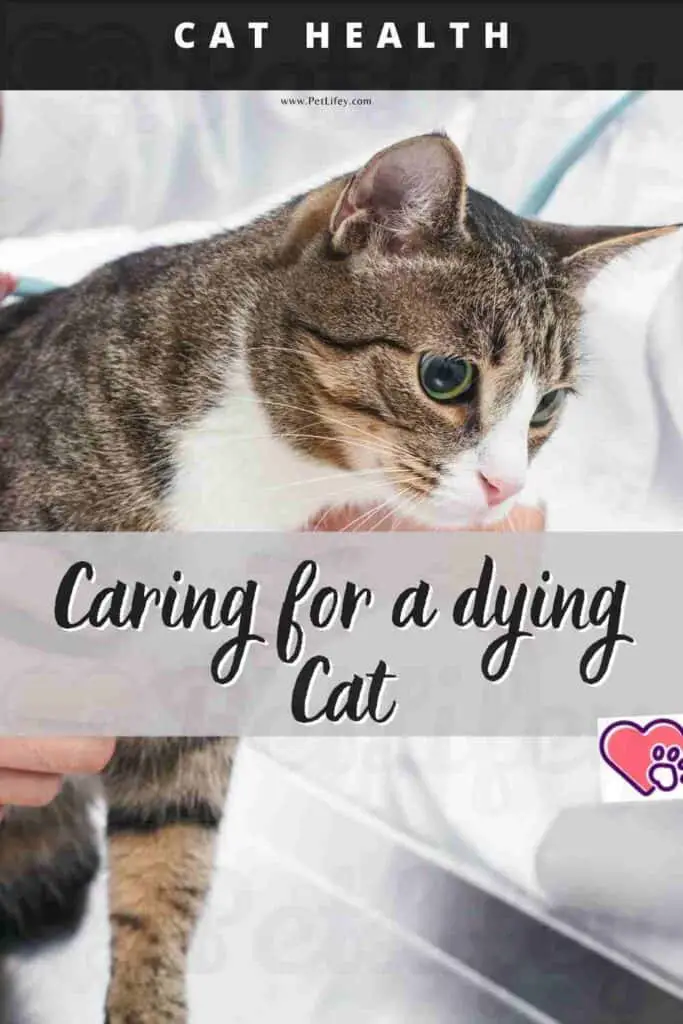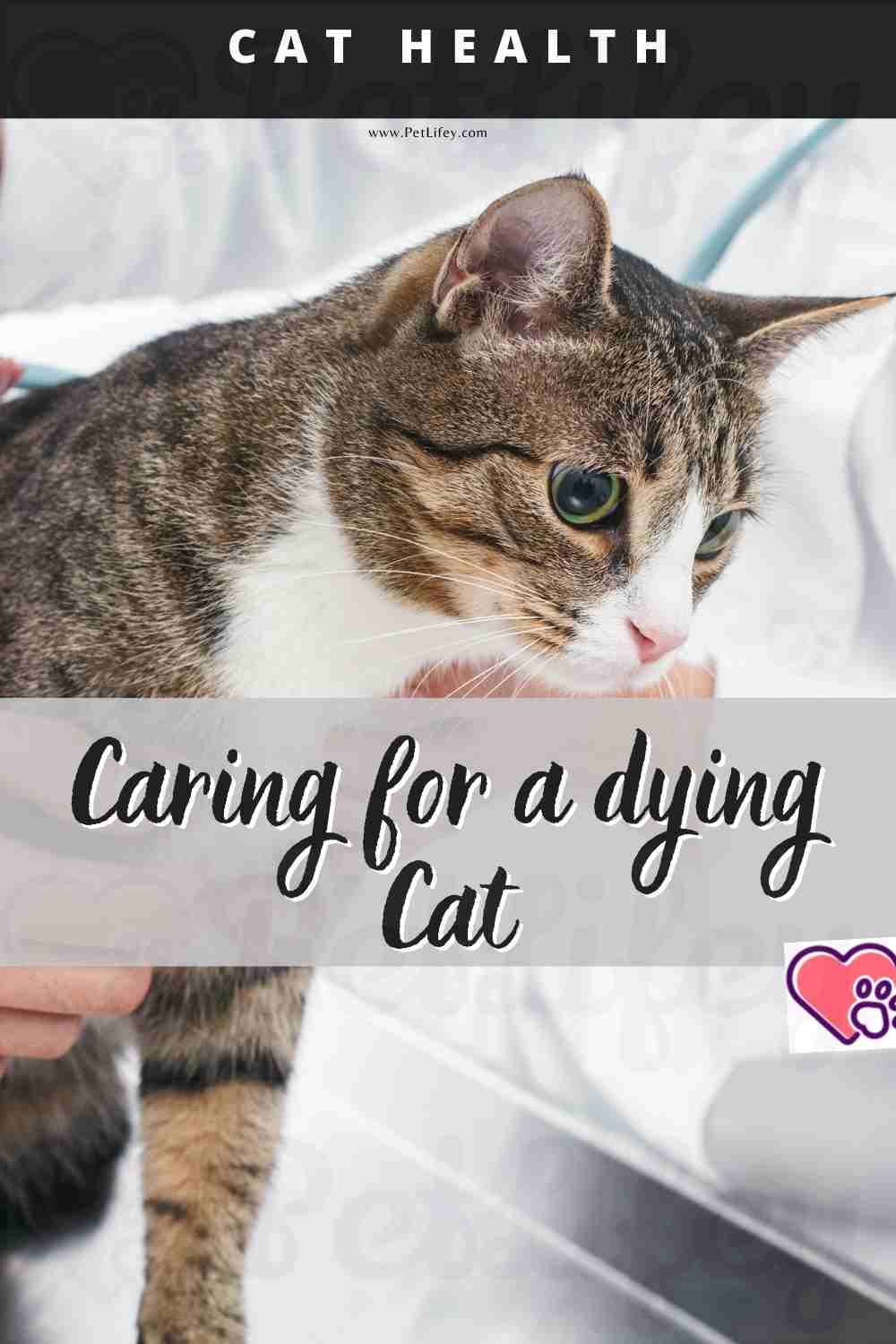Caring for a Dying Cat: Essential Comfort Measures and Care Tips

When your cat is approaching the end of its life, it’s essential to provide care that is both compassionate and comforting. Understanding the signs that a cat is nearing the end can prepare you to make their final days as peaceful as possible. Your cat may show a decreased interest in food, less engagement with their surroundings, and a significant change in their sleeping patterns, often seeking isolation.
Providing a comfortable environment is key. This includes creating a warm and quiet space with extra bedding, such as pillows or blankets, where your cat can rest undisturbed. Being familiar with palliative care measures, which focus on relieving discomfort and providing a serene atmosphere, is also beneficial. Your attention to their needs, through gentle interactions and keeping them close to family, can offer the solace and security your feline friend requires during this sensitive time.
Recognizing the Signs of a Dying Cat
It’s important to understand the signs of decline in your cat’s health, which can include physical and behavioral changes indicating that it may be nearing the end of its life.
Physical Indicators
- Lethargy: Your cat may show a significant decrease in activity, moving very little and reacting slowly to stimuli.
- Loss of Appetite/Not Eating: A noticeable disinterest in food, even favorite treats, could be a sign.
- Not Drinking/Dehydration: Observe for a reduced intake of water and signs of dehydration.
- Abnormal Breathing: Difficulty or changes in breathing patterns, such as panting or gasping, may occur.
- Sleeping More: An increased amount of time spent sleeping or a deep, unresponsive type of rest can be a sign.
- Unkempt Appearance: If your cat stops grooming itself, it may have a messy coat and look generally neglected.
Behavioral Changes
- Withdrawal: Your cat might hide more or seek isolation from people and other pets.
- Altered Sleeping Locations: Preferring cooler or more secluded spots for rest.
- Seizures: In some cases, cats may experience seizures as their health declines.
Remember, these signs might not always indicate dying but can suggest serious illnesses requiring veterinary attention.
Understanding Terminal Illnesses in Cats
When your cat faces a terminal illness, understanding the disease and your cat’s health challenges is crucial to providing the necessary care and comfort.
Common Diseases
Terminal illnesses in cats often include cancer, chronic kidney disease (CKD), and other progressive conditions that lack a cure. Recognizing these diseases early can lead to better management and palliative care.
- Cancer: A leading cause of death in cats, presenting through various symptoms like weight loss, lethargy, and sometimes more specific signs depending on the cancer type.
- Chronic Kidney Disease: Often seen in older cats, characterized by gradual loss of kidney function over time. You might observe increased thirst, weight loss, and decreased appetite as key indicators.
Detecting Serious Health Challenges
Early detection of health challenges in your cat can often be subtle but is vital for their quality of life during terminal stages.
- Look for behavior changes such as reduced interaction, hiding, or decreased activity levels, which might signal discomfort or pain.
- Monitor physical symptoms like changes in appetite, unexplained weight loss, or difficulty breathing, which warrant immediate veterinary attention.
Understanding these elements helps you provide the best care for your cat through informed, compassionate decisions during their time of need.
Providing Comfort to a Dying Cat
Caring for a dying cat focuses on reducing stress and pain to ensure maximum comfort during their final days. Proper setting and proactive management of discomfort are crucial.
Setting Up a Comfortable Space
Your priority should be creating a serene environment. Set up an area with extra bedding to cushion and support your cat. Heated cat beds can offer warmth and ease achy joints, which is particularly beneficial if arthritis is a concern. Make sure the space is quiet, away from heavy foot traffic and loud noises, to help your cat rest more peacefully.
Managing Pain and Discomfort
Regularly consult with your veterinarian to manage your cat’s pain with appropriate pain relief medications. It’s essential to monitor for signs of pain or cachexia (wasting), adjusting treatments as needed. If you notice your cat developing pressure sores, provide soft surfaces and turn them gently every few hours to alleviate the pressure on one side.
Special Considerations for Mobility
As their mobility decreases, your cat may have trouble reaching their favorite spots. Introduce ramps or stairs to help them move comfortably without straining. Avoid making them jump or climb steep surfaces, and always ensure that food, water, and litter are accessible without much effort.
Nutritional Support and Hydration
When caring for a dying cat, providing suitable nutrition and maintaining proper hydration are crucial to comfort your pet. These aspects should be adapted to the cat’s changing needs and abilities.
Feeding Assistance
Your cat may experience a decreased appetite, yet it’s important to continue offering food to meet energy requirements. High-calorie pastes or liquid diets that are easier to consume may be appropriate. If your cat is reluctant to eat solid foods like dry kibble, try offering wet food which is often more appealing and easier to ingest.
- Appetite: Look for any preferences your cat may show and offer small, frequent meals.
- Assisted feeding: Use a syringe for liquid diets if your cat is unable to eat on its own.
Hydration and Fluids
Hydration is critical to keep your cat comfortable. Cats with a reduced desire to drink may need your assistance to maintain adequate hydration levels.
- Water: Ensure continuous access to fresh water; consider using a shallow dish to make it easier to drink.
- Hydration aids: Utilize wet food with high moisture content or offer a cat-specific broth to increase fluid intake.
- Signs of dehydration: Watch for sunken eyes or a lack of elasticity in the skin, which may indicate dehydration.
Remember, your veterinarian can offer guidance on the most appropriate nutrition and hydration methods for your cat’s condition.
Coping with Incontinence and Grooming
When your cat is nearing the end of its life, it may struggle with incontinence and maintaining its grooming habits. This can lead to an unkempt appearance and odors that require your attentive care.
Maintaining Cleanliness
Incontinence can be challenging for both you and your cat, leading to unintended urine or fecal leakage that causes odors and discomfort. To help maintain cleanliness:
- Provide washable bedding: Opt for layers that are easy to clean and change. Use waterproof mattress protectors to safeguard furniture.
- Regularly bathe your cat: Gently clean your cat with a damp cloth or pet wipes, especially after accidents, to prevent skin infections and reduce odor.
- Use pet-safe detergents: When laundering bedding and blankets, choose detergents that are non-toxic to pets.
Adjusting Litter Box Usage
Cats with declining health may find it difficult to access or use the litter box properly. Implement the following strategies:
- Lower-sided litter boxes: Choose litter boxes with low sides for easy entry and exit.
- Multiple locations: Place several litter boxes around your home to minimize the distance your cat has to travel when the need arises.
- Consistent cleaning: Keep the boxes clean to encourage usage; soiled litter can deter your cat and contribute to an unkempt state.
Deciding on Euthanasia and Palliative Care
When caring for your dying cat, considering their quality of life is essential. You will have to make critical decisions about euthanasia and palliative care as guided by a veterinarian.
Evaluating Quality of Life
Assess your cat’s daily life by noting their level of discomfort, appetite, mobility, and interest in surroundings. Use these specific indicators to gauge quality of life:
- Pain Management: Is your cat experiencing pain that is not managed with treatments?
- Hydration and Nutrition: Is your cat able to eat and drink sufficiently?
- Hygiene: Can your cat groom itself or maintain cleanliness after eliminating?
- Happiness: Does your cat express its usual demeanor or signs of pleasure?
Consult with your veterinarian to interpret these signs and understand whether palliative care can effectively maintain a good quality of life for your cat, or if it’s declining.
Exploring Euthanasia Options
Euthanasia is a responsible and compassionate option when a cat’s suffering is overwhelming and their quality of life has deteriorated significantly. Examine the following:
- Method: Typically consists of an overdose of anesthetic, ensuring a peaceful and painless passing.
- Location: Decide if the procedure will occur at home or in a clinic. Your cat’s comfort should be a priority.
- Aftercare: Plan for aftercare options, such as burial or cremation.
Speak with your veterinarian to understand the process thoroughly. They will also help you consider if and when euthanasia is the most humane choice for your cat, encompassing both your pet’s well-being and your emotional readiness.
Preparing for the Final Stages
As your cat approaches the final stages of life, knowing how to provide end-of-life care and handle death can make this difficult time more compassionate and dignified for your beloved pet.
End-of-Life Care
At this stage, your cat’s needs will intensify and they will require more in-depth care. Collaborate with your veterinarian to understand the specific stage of decline and create a suitable care plan. Here are some ways to ensure comfort:
- Environment: Keep their resting area quiet, warm, and easily accessible. Consider extra padding like blankets for comfort.
- Nutrition: Your cat may lose interest in food. Offer small, palatable meals and ensure fresh water is always available.
- Hygiene: Maintain cleanliness, as your cat might become incontinent. Regularly change their bedding and be gentle when cleaning them.
- Medication: Administer any prescribed medication to manage pain or symptoms, as directed by your veterinarian.
- Presence: Simply being there for them can be a great source of comfort. Speak softly and offer gentle strokes.
Handling Death
Death is an inevitable part of the end-of-life process. Prepare yourself for the signs and the moment:
- Recognition: Acknowledge the indicators of your cat’s impending passing, such as labored breathing or disinterest in their surroundings.
- Decisions: Decide beforehand about aftercare options and consider euthanasia if recommended by your veterinarian to alleviate suffering.
- Support: Enlist the help of family or a pet grief counselor to manage your feelings during this time.
- Documentation: Make sure you have your cat’s medical history and your veterinarian’s contact information readily available, should you need it quickly.
Remember, through attentive care and a peaceful environment, you can help ease your cat’s journey through their final days.
Support Therapies and Alternative Measures
As your cat approaches the end of its life, supporting their comfort is paramount. Alternative therapies such as acupuncture and massage can be integral to palliative care, providing relief and enhancing quality of life.
Considering Acupuncture and Massage
Acupuncture for cats involves the insertion of very fine needles into specific points on the body to alleviate pain and improve energy flow. It’s important to seek a veterinarian with experience in feline acupuncture, as they will understand the intricacies of cat physiology and behaviors. Acupuncture can:
- Reduce pain: By stimulating nerves, it releases endorphins, which are natural pain-relievers.
- Improve mobility: Especially beneficial if your cat suffers from joint pain or muscle stiffness.
Massage is another gentle therapy that you can often administer yourself, with guidance from your vet or a pet massage therapist. It serves to:
- Relax your cat: Gentle strokes can soothe and provide comfort.
- Promote circulation: Help in reducing stiffness and improving your cat’s overall well-being.
When considering these therapies, always consult with your veterinary to ensure they are suitable for your cat’s specific condition.
Remembering and Honoring Your Cat
When the time comes to say goodbye, creating lasting memorials can help you cherish the memories of your beloved cat. These memorials serve as a tribute to the joy and companionship your cat provided throughout their life.
Creating a Lasting Memoriam
- Viewing Stones and Plaques: Consider placing a memorial stone or plaque either indoors or in your garden. This can be a simple stone with your cat’s name, or a more elaborate one with a message or a quote that resonates with your feelings.
- Photographic Memories: Create a photo album dedicated to your cat. Choose photos that capture their personality, favorite toys, and those heart-warming moments you shared. This album can be a physical book or a digital collection.
- Memory Box: Gather items that were special to your cat—such as a favorite toy—and place them in a memory box. This tactile memoriam lets you feel close to your cat by having a piece of their life preserved.
- Custom Artwork: Commissioning a piece of art whether a painting, drawing, or digital piece can capture the essence of your cat’s appearance. Having it displayed in your home can serve as a constant reminder of their presence.
- Engraved Jewelry: Wearable memorabilia like a necklace or bracelet with an engraving of your cat’s name or a depiction of them can keep your cat close to you at all times.
Remember, the most important aspect of honoring your cat is choosing memorials that speak to the unique bond you shared. Whether it is a stone, a photo, or a custom piece of art, these memorials will ensure your cat’s legacy lives on.







